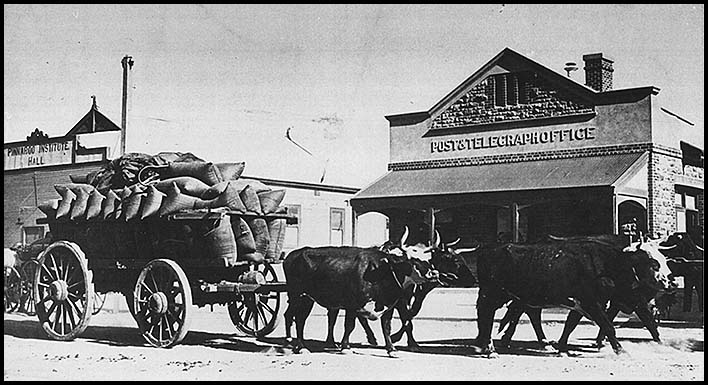Telegraph offices in the Tailem Bend - Pinaroo to Border Town region.
- Home, index, site details
- Australia 1901-1988
- New South Wales
- Overview of NSW
- Telegraph lines
- Telegraph Offices
- Date stamps
- Forms
- Envelopes
- Rates
- Stamps
- Queensland
- Overview of Qld
- Telegraph lines
- Telegraph offices
- Date stamps
- Forms
- Envelopes
- Rates
- Stamps
- South Australia
- Overview of SA
- Telegraph lines
- Telegraph Offices
- Date stamps
- Forms
- Envelopes
- Rates
- Stamps
- Tasmania
- Overview of Tasmania
- General developments
- Reports
- Organisation
- Telegraph lines
- Telegraph Offices
- Date stamps
- Railway lines
- Forms
- Envelopes
- Rates
- Stamps
- Overview of Tasmania
- Victoria
- Overview of Vic.
- Telegraph lines
- Telegraph offices
- Date stamps
- Forms
- Envelopes
- Rates
- Stamps
- Ephemera
- Western Australia
- Overview of WA
- Telegraph lines
- Telegraph Offices
- Date stamps
- Forms
- Envelopes
- Rates
- Stamps
| Border Town | Lameroo | Meningie | MacGrath's Flat | |
| Pinnaroo | Tailem Bend | Wellington |
Border Town. See entry elsewhere. |
The Advertiser of 4 April 1911 reported that, as of the previous day, "The post and telegraph at Lameroo is complete and the operator is in charge but the staff is insufficient for the work". "Tenders are being called by the Works and Building Department of the Commonwealth for the erection of post and telegraph offices at Pinnaroo and Lameroo respectively". (19 May 1911). |
|
|
A Telegraph Office was opened on 29 November 1873. Two days before, the South Australian Advertiser (p. 3) anticipated that "on the first of next month we are to have the use of the Telegraph in this township (Meningie) so connecting us with all parts of the colony". |
An incident at Meningie in November 1868 underlined the situation in many remote communities and their need for a telegraph station. The South Australian Chronicle for 7 November reported:
|
|
The Telegraph Office opened on 30 January 1862 (as MacGrath's Flat). The Post Office had opened in 1858. On 17 June 1862, the Post Office was reopened at the Telegraph Office.
The Telegraph Office closed on 29 November 1873 and the Post Office closed on 31 March 1882. A Telephone Office opened on 20 August 1923 but closed in 1927. |
|
Given the reference to telegrams in the March 1911 report below, it can be assumed that the telegraph office had opened in July 1910. Other records claim that the Telegraph Office was opened at the Railway Station in March 1910 but it was transferred to the Post Office in March 1911. A Post Office was opened in December 1905. In 1901, the State Government spent considerable time in discussing the Pinnaroo Railway Bill. |
|
|
The Pinnaroo and Border Times of 17 March 1911 ran the following story:
|
|
The Telegraph Office was opened at the Railway Station when it opened in 1886 - a year before the town was proclaimed. On 28 November 1913, the new Post Office at Tailem Bend was opened.
|
 Tailem Bend. 3 January 1940. Usual postal date stamp. |
On Saturday 22 September 1922, the new race course was opened. The course was situated almost within the town and a telegraph office was also expected to open on that day at the course. The Race Club was a special feature of the town. In 1929, considerable damage was inflicted on the town - and on the Club. A few months later however, all repairs had been completed and "special provision was made to accommodate all motor inside the course grounds. Patrons were able to view the races without leaving their cars if they desired to do so. The totalisator was improved and additions made to the stalls. The telegraph office on the ground received attention and the secretary's office was improved". |
|
In the early 1890s in South Australia, there was considerable discussion of the need to open up areas in the far eastern and south-east region near the Victorian border to new settlement. To achieve this end, it was planned to construct a Railway line towards Pinnaroo. Part of the incentive for this initiative was the very high rate of unemployment in South Australia about 1893. Although the Government had tried to develop various work schemes, these did little to decrease unemployment. The Government wanted to do more and bring about a more permanent settlement by encouraging people to be got onto the land in accordance with the provision for village settlement passed by Parliament in 1893.
The unemployed men were informed that the best thing they could do was to form themselves into associations and move on to land as soon as it was available. The Pinnaroo Bill, which would have provided work for many, had unfortunately been thrown out by the Legislative Council. "The men must make some sacrifices for their families and go back on to the land under the Village Settlement scheme".

